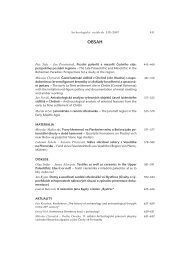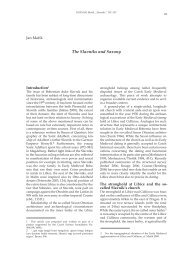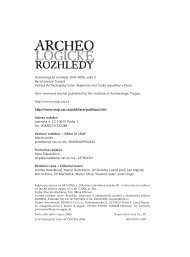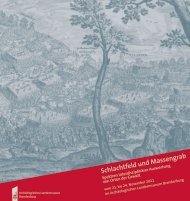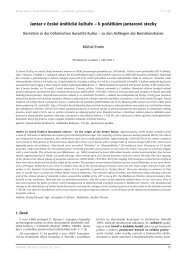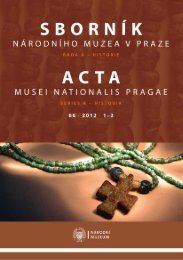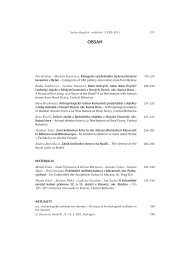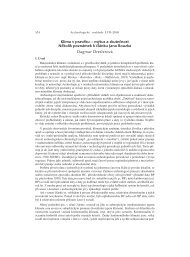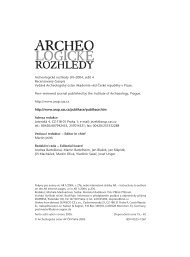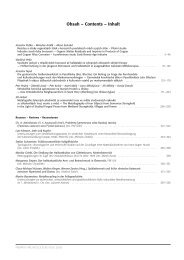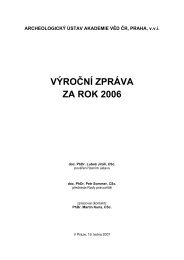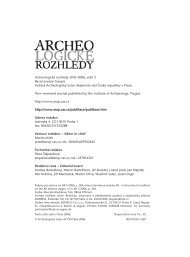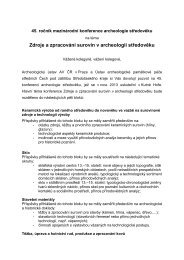Archeologické rozhledy 2009 - Archeologický ústav AV ČR
Archeologické rozhledy 2009 - Archeologický ústav AV ČR
Archeologické rozhledy 2009 - Archeologický ústav AV ČR
You also want an ePaper? Increase the reach of your titles
YUMPU automatically turns print PDFs into web optimized ePapers that Google loves.
116B¤EZINOVÁ –POPPOVÁ URBANOVÁ: Fragmenty textilu na bronzovém vûdru …Košnar, L. – Waldhauser, J. 1997: Archeologie Germánů v Pojizeří a v Českém ráji. Praha – Mladá Boleslav.Krekovič, E. 1993: Pohrebný rítus a sociálna struktura. In: E. Krekovič ed., Kultovné a sociálne aspektypohrebného rítu od najstarších čias po súčasnost, Bratislava, 6–10.Landovy zápisníky: Archiv Oddělení prehistorie a protohistorie Národního muzea v Praze.Laux, F. 1992: Überlegungen zu den germanischen Fürstengräbern bei Marwedel, Gde. Hitzacker,Kr. Lüchow-Dannenberg. Bericht der Römisch-Germanisches Komission 73, 315–376.Maik, J. 1988: Wyroby włókiennicze na Pomorzu z okresu rzymskiego i ze średniowiecza. Acta ArchaeologicaLodziensia 34. Wrocław – Warszawa – Kraków – Łódź.— 2001: Recent textile finds of the Roman period in Poland. In: P. Walton Rogers – L. Bender Jørgensen –A. Rast-Eicher eds., The Roman textile industry and its influence, Oxford, 105–112.— 2005: Tkaniny z grobu książęcego v Leśnie. In: H. Rząska – K. Walenta edd., Brusy i okolice w pradziejachna tle porównawczym, Brusy, 98–111.— 2007: Tkaniny z pomorskich cmentarzysk kultury wielbarskiej w świetle najnowszych badań. In:M. Fudziński – H. Paner, Nowe materiały i interpretacje. Stan dyskusji na temat kultury wielbarskiej,Gdańsk, 97–108.Motyková–Šneidrová, K. 1967: Weiterentwicklung und Ausklang der älteren römischen Kaiserzeit in Böhmen.Fontes Archaeologici Pragenses 11. Pragae.Novotná, M. 2008: Analýza vzorků z bronzového vědra z Řepova inv. č. 52979. Nepubl. zpráva depon. in:Oddělení prehistorie a protohistorie NM Praha.Peška, J. – Králík, M. – Selucká, A. 2006: Rezidua a otisky organických látek v korozních produktech mědia jejích slitin. Památky archeologické 97, 5–46.Peška, J. – Tejral, J. 2002: Königsgrab von Mušov. Mainz.Sakař, V. 1970: Roman Imports in Bohemia. Fontes Archaeologici Pragenses 14. Pragae.Schlabow, K. 1976: Textilfunde der Eisenzeit in Norddeutschland. Neumünster.Schönfelder, M. 1994: Bear – Clar in Germanic gratis. Oxford Journal of Archaeology 13, 217–227.Sklenář, K. 2003: Archiv nálezových zpráv Oddělení prehistorie a protohistorie Národního muzea v Praze.In: Zprávy České archeologické společnosti – supplément 51, Praha, 25.Šimek, E. 1923: Čechy a Morava za doby římské. Praha.Walton, P. – Eastwood, G. 1988: A brief guide to the cataloguing of archaeological textiles. London.Textile fragments on a Roman period bronze bucket from Řepov,Central BohemiaTwo larger metal vessels positioned next to each other–a bronze bucket and a pan with a maenadhead and a hang ring–were found at a depth of nearly 1 m at the eastern edge of Řepov municipality(Mladá Boleslav distr.) in 1904. One of the vessels was filled with smaller items. The find wasinterpreted as being the remains of a skeleton grave of a prominent individual from the ruling class(judging by the nature of the grave items, probably a man), who was probably buried here in the firsthalf of the 2 nd century (B2 horizon). The assemblage was handed over to the National Museum inPrague in 1909, in whose collections it is still filed under Inv. no. 52968–52982. In addition to theaforementioned two vessels, the assemblage also contains a colander and ladle set (the ladle stampedwith the lettering L COMPITVRICIN and ///• POLIBI) and a shallow bronze bowl, bronze forgingsfor two drinking horns decorated with silver rivets, a ring, razor and scissors (Karasová 1998, 79;Sakař 1970, 40; Motyková-Šneidrová 1967, 40).The surface of the bucket is a veritable treasury of organic remains. Almost half the outer surfaceis covered by fragments permeated with corrosion or impressions of various textiles, twisted yarn,grass impressions and remains of animal hair, which is the only thing also to have been preservedon the inner surface of the walls and base of the vessel. Most interesting are the remains of textiles,which were made using several textile techniques: most of the vessel surface is covered with a finefabric laced in a plain weave and by free twisted yarns without interlacing; the outer side of the basefeatures two small impressions of fabric with twill weave and a small fragment of band made ona tablet loom.



